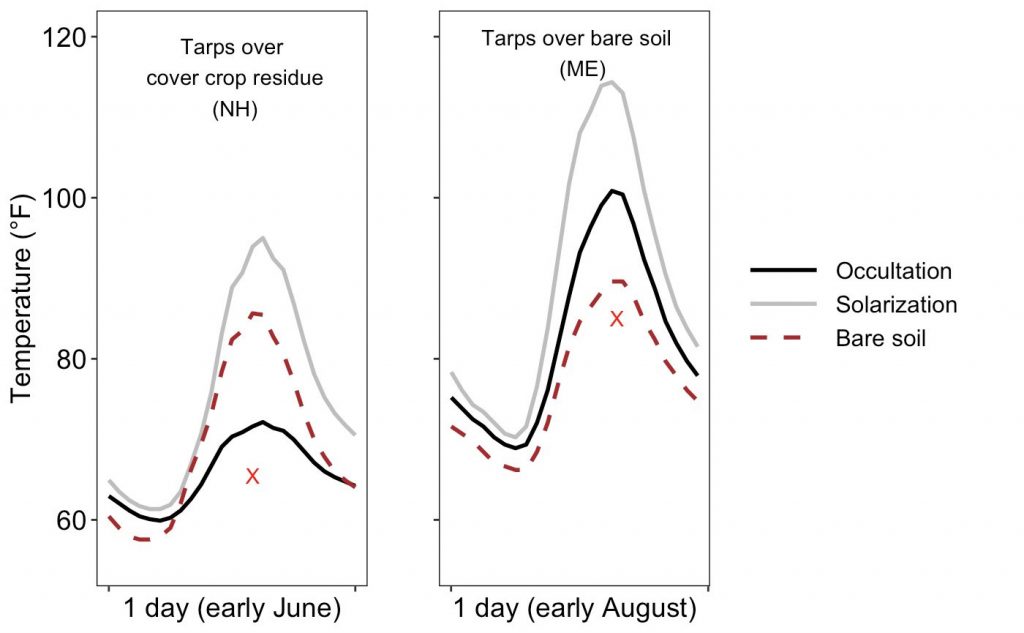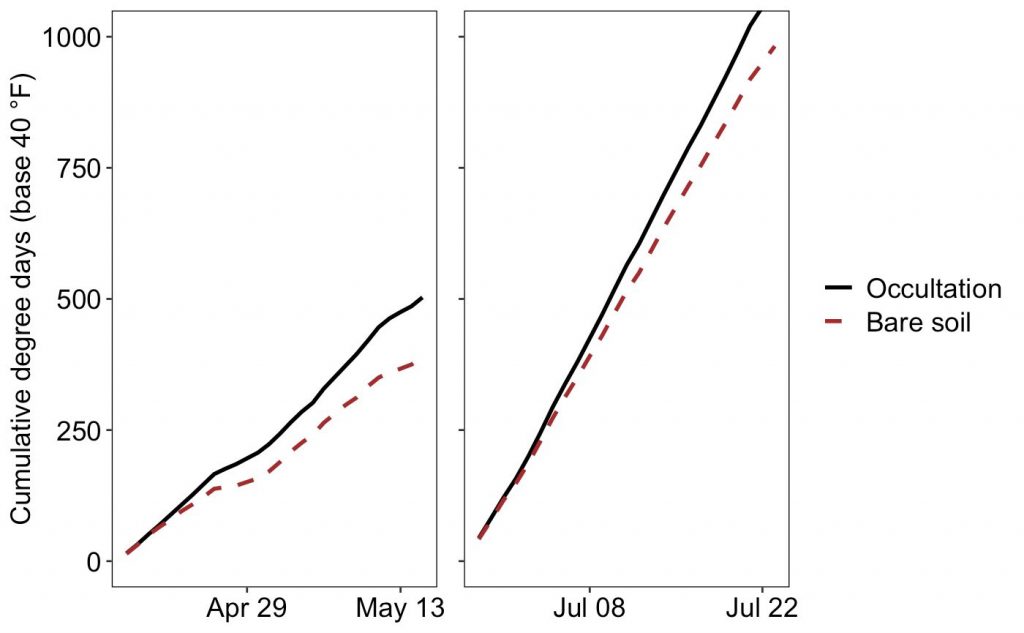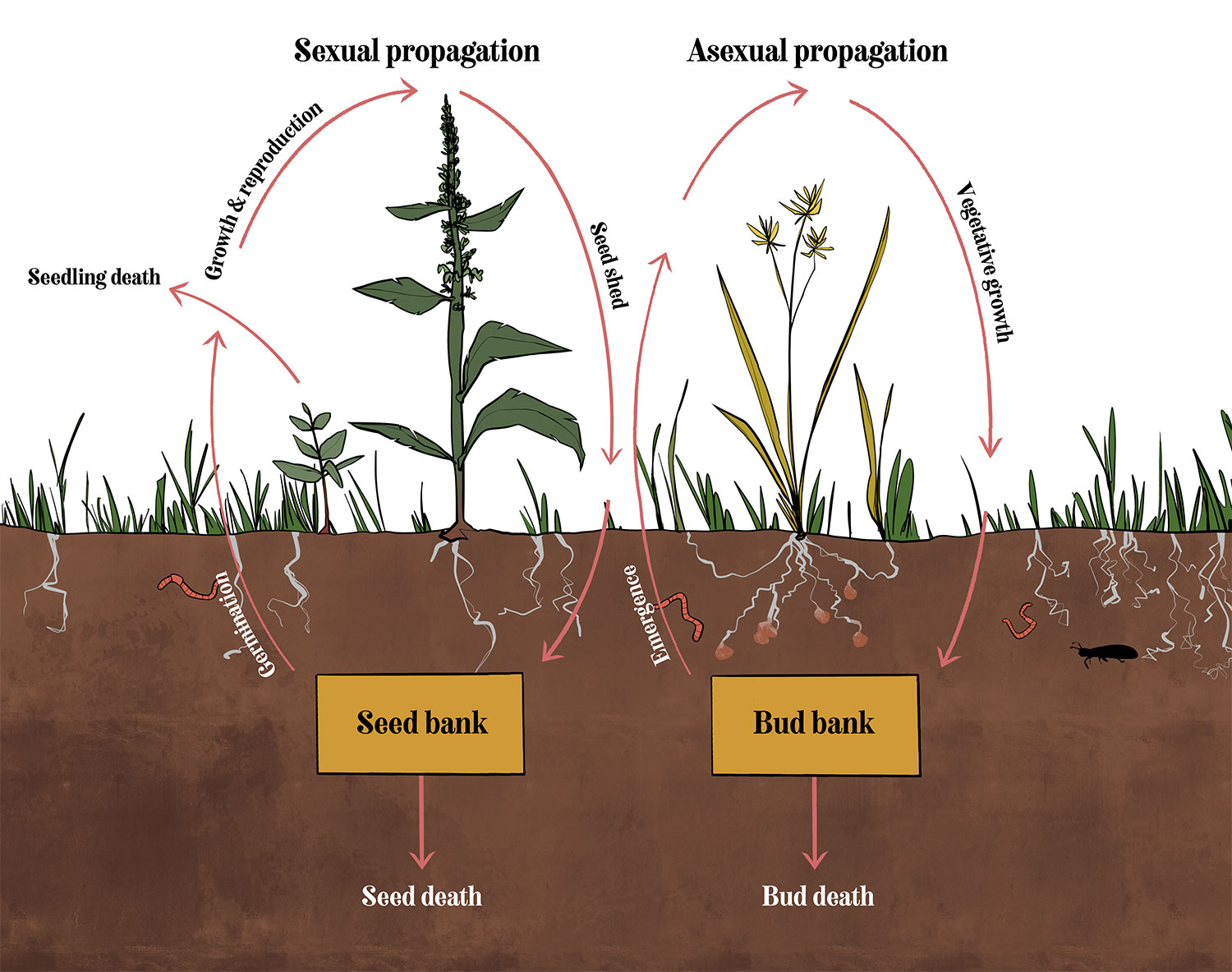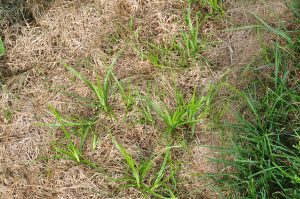Bulletin #1075, Tarping in the Northeast: Types of Tarps and How They Work
Tarp types
Tarps come in different materials, sizes, and thicknesses and vary in permeability, cost, and longevity (Table 1). For occultation, polyethylene silage tarps—made for excluding light and water from silage bunkers—or “ag plastic” are most commonly used because they are cost-effective, durable, and allowable under National Organic Program (NOP) rules. Landscape fabrics including woven polypropylene ground cover, which are often marketed as “permeable” are also popular. However, the permeability of these woven fabrics is limited and semi-permeable is a more accurate descriptor; water will still run off them. Black plastic billboard tarps have been favored in the past by producers because of their thickness (11-15mil), weight, and stiffness, but their use is disallowed under NOP standards because they are made of polyvinyl chloride (PVC). Woven blue poly tarps are easily accessible, but their utility is limited for field applications. For solarization, salvaged greenhouse plastic can be used and may be preferable to new clear tarps for both cost and efficacy (Avissar et al., 1986). Double layers of clear plastic, or clear on top of black, can further increase efficacy in some applications when more heat is needed (Mahrer and Shilo, 2012). If you have questions about using tarps in certified organic production, please discuss them with your certifier.
How tarps work
Occultation and solarization change light, temperature, and moisture dynamics at the soil surface. Effects on these conditions, in turn, affect biological processes such as photosynthesis, weed germination, and insect and microbial activity, which regulate the availability of nutrients like nitrogen. Understanding the mechanisms through which tarps work can help inform which type of tarp to use and how long to deploy it in a given context.
Light
The word occultation means to hide or block light, and black and other opaque tarps do just that. Occultation prevents photosynthesis and plant growth. How long plants can persist without light for photosynthesis depends on the temperature, species, maturity of the plant, and whether the plant has belowground vegetative propagules like rhizomes or tubers. Solarization, on the other hand, allows light through and relies on changes in temperature, discussed below, to kill plants.
Soil moisture
Managing soil moisture is central to successful tarping. Available soil water is an important factor that regulates biological processes, such as weed seed germination and microbial activity. These processes are generally greatest when soils are moist but not saturated. Moisture also increases heat conductance in soil, resulting in greater temperatures, which also influence germination and microbial activity. The effects of tarping are therefore strongly dependent on soil moisture at the time of tarp application. In some cases, it may be beneficial to irrigate prior to tarping.
Once applied, impermeable tarps generally “hold” moisture and maintain it at a relatively constant level for the duration of the tarping period. The exception to this is if edges are not sealed during solarization, which can lead to soil moisture losses from condensation. Holding soil moisture with a tarp can be advantageous because it helps ensure that there is adequate—but not excessive—water for the following crop. Woven landscape fabric also reduces evaporation from soils, but allows for some rainfall to infiltrate. When there is little or no precipitation, soil under landscape fabric will likely lose moisture over time.
By excluding precipitation, impermeable tarps can serve as a water management tool. For example, if applied over winter or prior to wet periods, tarps can improve field access in early spring. This can be especially valuable in soils that are not well drained. Excluding precipitation also reduces leaching losses, meaning tarps help retain mobile nutrients, like nitrate, in the soil (Lounsbury, 2021; Rylander et al., 2020a). This keeps nutrients out of waterways, instead of keeping them on the farm and available for future crops. However, when deployed for an extended time period and over a large area, tarps may prevent important soil water recharge from precipitation events.
Soil temperature
Occultation and solarization both affect soil temperature but in different ways. Solarization traps heat from solar radiation and creates conditions inhospitable to plant growth. The time required for solarization is a function of solar radiation, air temperature, wind speed, and moisture. In the Northeast, less than two weeks of solarization can be effective during average weather around the time of the summer solstice. If temperatures are not high enough, however, plants can thrive in a mini greenhouse created by the tarp. Burying tarp edges during solarization is critical to its efficacy by trapping heat and retaining moisture.
Because the absence of light is already inhospitable to plant growth, occultation can be effective across a wider range of ambient air temperatures, levels of solar radiation, and with a variety of edge securement methods. Black tarps transfer heat via conduction or direct contact. To raise soil temperatures with occultation, there must be tarp-soil contact. If there is something creating an air gap, such as cover crop mulch in a rotational no-till practice, a black tarp can lower maximum soil temperatures compared to no tarp at all, as illustrated below.

The cumulative effects of occultation on soil temperature are shown in the figure below. The difference in cumulative “degree days” between occultation and bare soil is much greater in spring than it is in mid-summer. These temperature effects in spring are likely to have a larger effect on biological processes like soil nitrogen mineralization and weed seed germination.

Weeds
Because tarping can alter light, moisture, and temperature conditions at different points in the weed life cycle, tarping practices offer ways to manage both living and lurking weeds. Living weeds are actively growing annual and perennial species. Lurking weeds include seeds in the seed bank and the belowground storage organs of perennials in the bud bank that will germinate and emerge, respectively, when they have the right conditions.

The shift to tarping as a primary weed management strategy may alter the weed communities present, creating problematic dominant species that are resistant to tarping. Nearly 10% of farmers using tarps reported that some weeds had become bigger problems since they began tarping (Rangarajan 2019). For many of these farmers, the shift to tarping was likely accompanied by a reduction in tillage, which is known to shift weed communities toward perennial species. Even though tarping can be a highly effective weed management tactic, relying on a single strategy can be problematic, and it is important to integrate tarping with other weed management practices including crop rotation, cover crops, mulching, and in some cases tillage. Understanding how different tarping practices affect weeds and at what stage in their life cycle is critical to integrating this powerful tool effectively into an overall weed management strategy.
Definitions
Seed bank: weed seeds in the soil that will germinate when they have the right combination of germination cues. These seeds can be of annual or perennial weed species.
Bud bank: belowground storage organs of perennial weeds including roots, rhizomes, tubers, and bulbs. New plants can emerge from these storage organs, and some types of organs (e.g. rhizomes) can help species spread.
Killing living weeds
Terminating growing weeds with a tarp after crop harvest or before planting another crop is a popular practice because it eliminates at least one tillage pass. Most annual weeds are effectively terminated with less than one week of tarping in the peak of summer but may take up to three weeks in cooler seasons. Fully killing perennial weeds poses a challenge because of the lurking bud bank, however.
Managing perennial bud banks
The underground storage organs of perennial weeds store enough energy reserves to survive winters and other difficult conditions. This translates to resilience in the face of tarping. Perennial weeds tend to be most vulnerable to weed management tactics like tarping when they are just emerging in the spring, with only a few leaves sprouted, as they have already drawn on stored sugar reserves to survive the winter and must further exhaust these reserves to form spring shoots. However, once shoots emerge and start photosynthesizing at full capacity, perennials can quickly replenish reserves.

While there is much research needed to understand the relationships between tarping and perennial weeds, there is currently enough evidence to say that some common perennial species on farms in the Northeast are not well controlled with tarping, and can even become worse. The tubers, or “nutlets,” and rhizomes of nutsedges (Cyperus spp.) are especially resistant to occultation. They are somewhat susceptible to solarization, however, when combined with tillage in the peak summer months (Johnson III et al., 2007). Other common perennials including quackgrass (Elymus repens (L.) Gould), field bindweed (Convolvulus arvensis L.), and Canada thistle (Cirsium arvense (L.) Scop.), which all spread via rhizomes, may be knocked back but not eliminated by short or mid-term (<6 weeks) periods of solarization and/or occultation. The lack of data specific to perennial weed control with tarps in the Northeast makes it challenging to offer management recommendations. This is further complicated since most studies investigating solarization for perennial weed control have used thin (e.g. 1-2 mil) new, clear plastic, which creates different thermal conditions than thicker (4-6 mil) reusable tarps (Elmore et al., 1993).
If perennial weeds are present in fields, farmers should be aware that tarping alone may not be sufficient to avoid problematic levels of these species. Using multiple tactics to deplete the storage organs of challenging perennial weeds may be necessary before relying on short-duration tarping.
Research on whether long tarping periods can deplete the bud bank has not been conducted in this region. If perennial weeds are present in fields, farmers should be aware that tarping alone may not be sufficient to avoid problematic levels of these species. Using multiple tactics to deplete the storage organs of challenging perennial weeds may be necessary before relying on short-duration tarping. Plowing a field with perennial weeds to pull up the storage structures and letting them dry in the sun weakens plants, and alternating this practice with tarping throughout a season may help control pernicious perennials. However, care should be taken not to inadvertently spread perennial weeds to new locations through this practice.
Managing weed seed banks
Weed seeds must receive signals, or cues, to germinate. These cues can include moisture, light, temperature, nutrients, and gases. Solarization and occultation regulate these cues differently, but both can encourage so-called fatal germination or death of a newly germinated seed. Dead white thread stage weeds that have apparently succumbed to intense heat (solarization) and/or a lack of light (occultation) after germinating are commonly observed following these practices. By increasing fatal germination, tarping can deplete the weed seed bank, killing many of the weeds that would have emerged during early crop growth. This gives crops a competitive advantage in the important early period of their growth. It is believed that this is the primary mechanism for weed suppression observed from tarping in the Northeast, and while research is limited, tarping durations beyond three weeks have not been shown to significantly increase fatal germination(Rylander et al., 2020b).
Some annual species, including purslane (Portulaca oleracea L.) appear unsusceptible to fatal germination induced by tarping and solarizing. Crabgrasses (Digitaria spp.) have shown condition-dependent results, with some farmers reporting increased abundance after tarping. In the absence of other weed competitors, these weed species can become dominant following tarping.
In warmer climates, thermal destruction (seed death) of some weed seeds as a result of very high temperatures under solarization has been documented. Evidence from Maine suggests that this occurs to a limited extent in the field, and to a greater degree in hoophouses (see stale seedbedding section). However, it is not believed to be a major pathway of weed seed loss under occultation because of lower temperatures. Other pathways for weed seed death, or loss of seed viability, include microbial decay and seed predation by invertebrates, rodents, and birds. It is unclear how or if tarping affects these pathways of seed loss. Researchers in New York found that more seeds of Powell Amaranth (Amaranthus powellii S. Wats), which is a kind of pigweed, remained viable under tarping than in bare, untarped soil. This suggests that the pathways for seed death are indeed affected by tarping, but the mechanisms are unclear and may be species-specific (Rylander et al., 2020a).
Practices like cover crop based rotational no-till, imported straw mulch, or deep compost mulch, which are often combined with tarping, manage lurking weed seeds by the opposite of fatal germination. By reducing germination cues like light, these practices prevent weed seeds from germinating altogether, keeping weed seeds in the seed bank. In other words, these practices do not deplete the weed seed bank, but, to different degrees, bury it. By reducing the number of weed seeds that germinate, these practices also reduce the number of weeds that can potentially go to seed. Preventing seed inputs is another important way to manage the weed seedbank.
Soil organisms
Because tarping modifies the soil environment, it can affect soil biological activity (i.e. how active organisms are) and the community (i.e. who is present). Many farmers have questions about these effects, but very little research has been conducted in climates like the Northeast and with occultation, which results in significantly lower temperatures than solarization. Warmer, wetter temperatures can increase microbial activity, but very high temperatures (e.g. >110°F) achieved during solarization can decrease microbial activity and kill non-heat tolerant microbes. However, research conducted in warmer climates suggests that beneficial soil microbes persisting deeper in the soil profile can re-colonize upper layers of soil quickly following solarization treatment (DeVay and Katan, 1991). Research investigating the effects of solarization on mycorrhizal fungi found that solarization for >50 days did not reduce the viability and presence of mycorrhizae, but that prolonged periods (>8 months) of bare soil without weeds following solarization did (Schreiner et al., 2001).
The effects of these practices on soil-dwelling arthropods have received little consideration to date, though early results from an ongoing study in Vermont found that diversity and abundance of aboveground arthropods were reduced during both occultation and solarization. These populations rebounded within three weeks compared to a cultivated control, however. The effects on belowground arthropods were inconclusive but showed a trend toward decreased abundance and diversity following tarping. It has been noted by many farmers that occultation seems to increase earthworm abundance compared to tilled areas, and this phenomenon has been validated in field research (Vallotton, 2018).
Soilborne Pathogens
We are aware of no published studies evaluating tarping for control of soilborne pathogens in our region. Previous research in other regions suggests that tarping does not result in hot enough soil temperatures to be consistently effective in cool northern climates like ours (Walters and Pinkerton, 2012). Nonetheless, it is likely that pathogens could be reduced under ideal conditions, or through some more creative applications of the practice. For example, theoretical work based on field studies in Maine suggested that the use of tightly-secured clear plastic tarps within a closed hoophouse achieved temperatures hot enough for control of several important pathogens including late blight (Phytophthora infestans), Alternaria leaf blight, and Verticillium wilt (Birthisel et al., 2019).
Anaerobic soil disinfestation (ASD), which also uses tarps, is a process for pathogen control in which organic materials are added to the soil, the soil is irrigated to saturation, and the tarps are applied and sealed. Microbes quickly use up the oxygen present, creating anaerobic conditions that have been shown to reduce pathogens and increase beneficial microbes. There is currently research underway in the Northeast on this practice, but it falls outside the definition of tarping that we use in this guide and is therefore not covered here. ASD is, however, another use for tarps on the farm.
Based on studies conducted outside our region, at soil temperatures between 99°F and 122°F, thermal death and population reduction of many pathogenic organisms takes between two and five weeks. The effect is greatest, and lasts the longest, in the upper layers of the soil. In instances where temperatures are not high enough to kill pathogenic microbes outright, studies using clear tarps suggest that their application may still result in some benefits to the crop due to delayed propagule germination and reduced pathogen growth rates.
As with using tarps to manage weeds, moisture is important for pathogen control because pathogens are typically more susceptible to thermal killing when wet than dry, and moisture helps conduct heat deeper into the soil profile. The addition of organic amendments like manure may create conditions in which oxygen is limiting, also reducing the populations of plant pathogens. This can be done in a controlled manner using anaerobic soil disinfestation (see inset), but may also occur to some degree under more typical applications of black or clear tarps with high levels of organic matter additions. It should be noted that low oxygen conditions are likely to also create conditions for denitrification, lowering soil nitrate content over time.
Soil Nitrogen
Tarping practices can have significant effects on soil nutrients, especially inorganic nitrogen, which is available for plant uptake. This occurs through changes to biological activity and water dynamics already discussed. An accumulation of nitrate under tarps has been observed in multiple research studies and on-farm samples. Because nitrogen mineralization—the transformation of organic nitrogen to inorganic forms—is a biological process, accumulation is minimal with very short duration tarping. However, high levels (i.e. >30 mg kg-1 nitrate-N) can be reached after three weeks, especially in the peak of summer when soils are warm and microbes are very active, and when there is high soil organic matter. Higher nitrate levels after tarp removal likely reduce the need for fertilizer applications. Predictive tools such as the pre-sidedress nitrate test (PSNT) were not designed for cropping systems using tarps, but may provide an indication of whether to delay or even eliminate fertilizer application. PSNT samples are easy for a farmer to take (similar to a regular soil sample) and analysis is affordable with quick turnaround results through most labs.
With higher levels of nitrate present and somewhat limited gas exchange under impermeable tarps, there have been questions about the potential for denitrification (the biological conversion of nitrate to gaseous nitrogen, which occurs under limited oxygen conditions). This has not been studied. The fact that substantial accumulation of nitrate occurs under typical tarping conditions suggests that the extent of denitrification is limited. However, certain conditions such as high organic matter inputs may lead to the creation of anaerobic or limited oxygen conditions and some denitrification may occur. It is possible to inadvertently create the conditions that are intentionally created for anaerobic soil disinfestation (i.e. sealed edges, high organic matter inputs, wet soil, and warm temperatures) with tarping, and this is likely to lead to some denitrification.
In complying with the letter and spirit of applicable laws and pursuing its own goals of diversity, the University of Maine System does not discriminate on the grounds of race, color, religion, sex, sexual orientation, transgender status, gender, gender identity or expression, ethnicity, national origin, citizenship status, familial status, ancestry, age, disability physical or mental, genetic information, or veterans or military status in employment, education, and all other programs and activities. The University provides reasonable accommodations to qualified individuals with disabilities upon request. The following person has been designated to handle inquiries regarding non-discrimination policies: Director of Institutional Equity and Title IX Services, 5713 Chadbourne Hall, Room 412, University of Maine, Orono, ME 04469-5713, 207.581.1226, TTY 711 (Maine Relay System).


